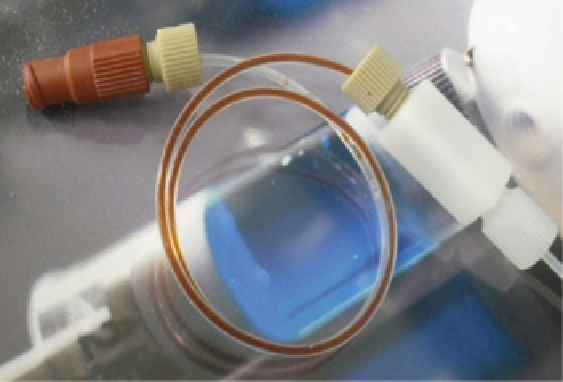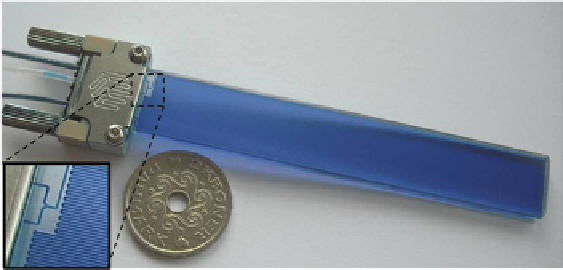Chemistry Reference
In-Depth Information
(a)
(b)
FIgure 4.2
(a) Microtube reactor packed with a silica-supported palladium phosphine catalyst. (b) glass fabricated microfluidic
device used for gas-liquid phase
11
CO carbonylation reactions (Figure reproduced with permission from ref. [106]).
C-11 isocyanate or C-11 ketene intermediates that undergo either reaction with a suitable nucleophile. [
Carbonyl
-
11
C]
diphenyl ureas and [
carbonyl
-
11
C]ethylphenyl carbamates respectively [120] have been prepared in this way using the high
pressure micro autoclave system (scheme 4.22).
in a typical procedure a mixture of rh(i) catalyst (typically [rhCl(COD)] and triphenylphosphine) and diazo precursor
were injected into the micro-autoclave reactor previously charged with
11
CO/He gas. The selected nucleophile (alcohol or
amine) is then added after a short time. A rh-carbenoid complex is initially formed on reaction with the diazo precursors
with concomitant loss of N
2
.
11
CO migratory insertion of
11
CO results in the rhodium-ketenyl complex and following nucle-
ophilic attack by an alcohol or amine give [
carbonyl
-
11
C]carbamates or ureas respectively. One drawback of this reaction
system is the use of diazo precursors that may not be possible to generate for the labelling of more complex molecules.
Free radical photo-initiated reactions of carbon monoxide provide an alternative route to the traditional metal catalysed
reactions for the introduction of CO into organic molecules. recently, these types of photo-initiated carbonylation have
been used to prepare C-11 labelled carboxylic acids [121, 122], esters [122-124] and amides [125] (scheme 4.23). in
comparison to the Pd- and rh-mediated reactions described above, these photo-initiated reactions can be used to label ali-
phatic molecules with
11
CO, which cannot be readily achieved via transition metal reactions owing to beta-hydride elimination
processes. The photo-initiated C-11 carbonylations were performed in a modified micro-autoclave system equipped with a
sapphire window to allow penetration of UV light [121]. The system was used to prepare a wide range of [
carbonyl
-
11
C]
carboxylic acids, esters, or amides from the corresponding alkyliodides and nucleophile (water, alcohol, or amine). The
reactor was typically pressurised to 40 mPa with
11
CO/He gas and then irradiated with UV light (280-400 nm). it was
necessary to have a photo-sensitiser in the reaction mixture (benzophenone or acetone) and polar solvents such as DMF or
DMsO to give higher rCys. Conversions of
11
CO were also found to be dependent on agitation of the solution, concentration
of alkyl iodide, and pressure and intensity of UV irradiation.


